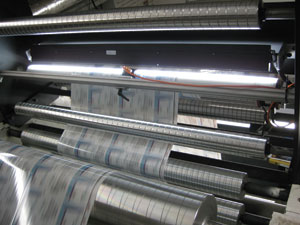Industry Q&A: Defect Detection
Detecting Smaller Defects at Higher Web Speeds
Gerry Stanford represents PC Industries for technical sales, and took time out to answer FP’s questions on inspection and detection.

 |
| Not all defect detection systems are created equal; varying types of films require varying types of system set ups. |
A:
In General:
There are multiple general factors to consider for defect detection, as well as some specifics that vary by application. The general factors cover the fundamental details about the press and types of jobs being run. These include your maximum web width, maximum web speed, and minimum defect size.
This information determines the correct camera resolution and computer processing requirements.
Application-Specific:
In the flexible packaging industry we see a wide variety of materials, and this can have an impact on the camera and lighting used for the application. For example, runs with holographic features don’t inspect well under normal, direct lighting and often require special lighting types, angles, or techniques to capture an accurate image. Some applications will require back-lighting, such as front to back registration for transparent films, and detection of pinholes in material. Likewise, low contrast print may require UV or other specialized lighting for the inspection camera and software to be able to distinguish between the substrate and print. Special consideration must also be given for substrates that are transparent, coated, or may wrinkle easily.
Hardware and Software:
It’s important to remember that a defect detection system is more than just a camera and lighting. The computer and software capabilities are just as important. These systems are typically installed in environments that are rough on electronics, so industrial components are a must. The system must be able to handle processing images from zero to full web speed as well as during speed changes. Both hardware and software should be stable and reliable enough that you won’t experience downtime due to failure. A robust software system will offer features beyond defect detection that are usually specific to the jobs being run. These features may include bar code verification and grading, FDA 21 CFR Part 11 compliance, OCR/OCV, dimensional gauging, and sequential number verification.
Usability:
It’s important to make sure that operators are properly trained and comfortable with using the inspection system. If a system is too difficult to set up or use, operators may not use it at all, and your investment will be wasted. It should be intuitive and quick to set up a new inspection, train a master image, and save the job setup information. When this job information is saved, it then becomes available for subsequent runs with a few clicks of the mouse or taps on a touch screen monitor. The ability to zoom in on defects will allow an operator to quickly and easily determine which defects must be corrected, and a defect roll map will allow those corrections to be made in a minimal amount of time.
Q: What kinds of trends/technologies is this sector seeing?
A: Recently, there has been a trend away from sampling defect detection toward 100 percent inspection. We’ve seen an increase in the number of mid- and wide-web packaging companies investing in 100 percent inspection in response to customer demands.
There has also been an increase in interest for color measurement systems. Spectrophotometry capabilities have improved drastically in the past couple of years, and now offer real-time reporting so adjustments can be made on the fly. In-line spectrophotometers are being used to enhance inspections system capabilities.
Q: What are your customers requesting in terms of products or service? What’s new and exciting at the company?
A: Advances in technology are providing printers 100 percent inspection at higher web speeds while detecting smaller defects. Beyond this, there has been a significant increase in the number of customers looking to add in-line color measurement. In response, PC Industries now offers the SpectroEdge inline spectrophotometer. The SpectroEdge can be integrated with existing inspection systems, and offers high-speed color measurement with real-time reporting. There has been a significant positive feedback on these new capabilities from our customers, and we’ve worked to make sure that this system is as intuitive to use as all our systems.
There has also been an increase in customer requests for the following inspection system features:
- Defect roll mapping: The ability to record the location of each of the defects on a roll and access later for editing and defect removal.
- Electronic file comparison (PDF Check): Customers can verify their master image against a customer approved PDF.
- Bar code verification: Allows the verification and grading of bar codes during inspection.
- Remote Support: Customers have been increasingly concerned about the quality of support that inspection providers offer. We offer 24/7 remote support and training to all our customers, and have received a great deal of positive feedback.
- Pre-registration: The pre-registration module analyzes small features in print, such as micro-dots, and provides the press with coordinate information to correct plate registration errors. We are currently working with a wide-web flexible packaging printer to implement this feature on all their presses.
PC Industries
(847) 336-3300; www.pcindustries.com
Looking for a reprint of this article?
From high-res PDFs to custom plaques, order your copy today!





